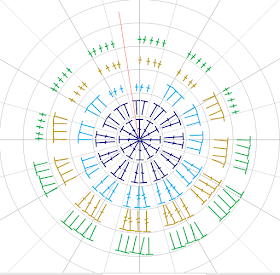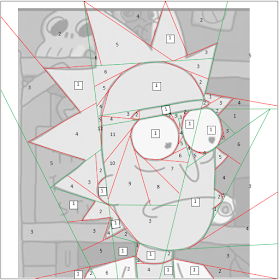 |
| Diamond stitch cone and strawberry, chocolate, and vanilla ice cream. |
 |
| Waffle stitch cone and raspberry, lime, and blue hawaiian sorbet. |
 |
| Yay mittens! |
I love ice cream in the winter. Also all the other seasons, but especially in the winter. These ice cream mittens are zero calorie and super fun to make.
This was a fun opportunity to combine some different textural stitches I've been figuring out. The cuff can be worked in either diamond stitch or waffle stitch or one of your own design. There are also tons of variations for the ruffle at the bottom of the scoops of ice cream. I used half double crochet and 3 scoops but you can really go wild. I also alternated between half double crochet and BLO + third bump hdc to make it look like the little lines that form when you scoop. The idea is to make the bottom part cone-y and the top part ice cream-y, so do whatever puts the nuts on your sundae.
You can customize the size to fit any hand during the first row. The stitch count will be slightly different depending on what style cuff you want because the stitches are worked in different multiples. It will be within a few stitches and I can't tell the difference in the two I made. I didn't finish my thumbs but you could if you wanted. I was playing around with the idea of making the top of the thumb part of the first scoop but then I got lazy.
I did plan ahead enough to leave a gap for my finger to stick out for my phone. You can really do this with any mitten pattern and it's really easy. Just make a chain or single crochet foundation row and skip some stitches in the appropriate place and keep going.
 |
| Hole for your finger! |
 |
| Peek-a-boo! |
The ruffle might be intimidating if you've never worked those 3D stitches before, but once you get the hang of it, you'll be thinking of everything you can do with it. I decided on mostly half double crochet stitches for this project and that's what the ruffle uses too. I tried a bunch of different stitch types and counts for the ruffle but I think I like this best (for this project at least).
Pattern
Stitches used (sort of a lot, sorry!): single crochet foundation row or double crochet foundation row, double crochet, half double crochet (plus increases and decreases), front post triple crochet two together, half double crochet 3D stitches, half double crochet worked in the back loop only + the third bump.
Yarn: worsted weight acrylic in multiple colors. I used whatever colors I had in my stash - just have fun it doesn't have to be perfect.
Hook size: I used a 4mm (size 8 or F) hook but use whatever you like with your yarn. I liked using a smaller size than the yarn called for to make the stitches tighter and less hole-y.
Gauge: Gauge is not super important, you just have to make sure you're choosing the correct number of stitches to start with. I made one of each type of mitten so the stitch count is slightly different but they both still fit. You can add or remove rows in several places to make it bigger or smaller.
Cone base (wrist):
- Option 1: Diamond Stitch Cone
Diamond shaped stitches are worked by alternating rows of double crochet and single crochet with long post stitches dipping into the rows below. Mooglyblog has a great project using this stitch. This pattern repeats over 4 stitches and 4 rows.
Row 1: SCFR 28 (this needs to fit around your wrist/forearm comfortably and can be any number in multiples of 4. 28 fit me best with my yarn and hook.) Slip to first stitch and use the tail to connect the bottom of the stitches.
Row 2: DC in each stitch (28)
Row 3: This is the first row of the diamond stitch with single crochets and long post stitches. Ch 1, sc 3, FPTRC2tog in the 2nd and 6th stitch from the first row of scfr. Skip the next stitch and sc 3. You'll then repeat this around, working 3 sc and then working post stitches together in the first row, skipping 3 stitches between each when you place the posts. (This can be confusing if you've never worked the diamond stitch before.)
Row 4: DC around (28)
Row 5: Ch 1, sc 1, FPTRC2tog, sk1, sc 3 (repeat around)
Row 6-9: repeat rows 2-5
Row 10: HDC around (28)
Don't break yarn - move down to hand section
- Option 2: Waffle Stitch Cone
The waffle stitch is worked in multiples of 3 stitches over two rows.
Row 1: DCFR 27 (this needs to fit around your wrist/forearm comfortably and can be any number in multiples of 3. 27 fit me best with my yarn and hook.) Slip to first stitch and use the tail to connect the bottom of the stitches.
Row 2: Ch2 and DC in the same space (or make a standing double crochet). Back post DC in the next 2 stitches. Repeat 1 DC, 2 BPDC around (27)
Row 3: Ch 2 (don't count this as a stitch) FPDC around the normal DC from the last row and DC normally into the 2 BPDC from the last row. Repeat this around.
Row 4-7: Repeat rows 2 and 3 twice.
Row 8. HDC increase once, HDC around (28) (this is because you need an even number in the next section)
Row 9. HDC around, working into the black loop and the third bump (3rd bump adds stability) (28)
Row 10: There's not a row 10 for this stitch. Have a drink - you've earned it!
Don't break yarn - move down to hand section
Cone top (hand): Using whatever base you selected, you will now start increasing in one side to make room for the thumb. I like to mark my increases with a stitch marker so I don't have to count: mark the first stitch of the first increase and the second stitch of the second increase and make your subsequent increases in the marked stitches. Move your markers up in each row.
Row 11: Both bases should have 28 stitches in their final row. Working into your base: HDC inc in the first two stitches and HDC around (30)
Row 12: HDC inc, HDC 2, HDC inc, HDC around (32)
Row 13: HDC inc, HDC 4, HDC inc, HDC around (34)
Row 14: HDC inc, HDC 6, HDC inc, HDC around (36)
Row 15: HDC inc, HDC 8, HDC inc, HDC around (38)
Row 16: HDC inc, HDC 10, HDC inc, HDC around (40)
Row 17: HDC inc, HDC 12, HDC inc, HDC around (42)
1st Ice Cream Scoop: In the first row, you will separate the thumb from the rest of the hand. If it feels wrong for your hand, you can move the stitches around a little for more or less thumb room.
Row 18: Place a stitch marker into the 2nd and 15th stitch to pin them together. You will be working single crochets in the back loop and the 3rd bump of the HDCs in the row below. With an ice creamy color, sc in the first stitch, then into the 16th stitch. The thumb is now isolated from the rest of the hand. (Try it on now and adjust it a little if it doesn't fit. Make sure the hand has an even number of stitches.) Sc around (28)
Row 19: HDC around (28)
Row 20: This row is the ruffle at the bottom of the scoop. We will be working around the half double crochets from the previous row. When you work into the top of the stitches, only work into the front loop. You will use the back loop in row 21, so be careful not to use it now. To create the ruffle, you'll be working 3D HDCs around the posts of each stitch and also into the top of the stitch and the sc from 2 rows ago. Ch 2. In the first stitch, work in the front loop only, HDC 2. Then you will work 2 HDC around the post of the next HDC from the previous round. (To do this, turn your work 90 degrees clockwise.) Then put 2 HDC into the Sc from 2 rows ago. Next, you'll work 2 HDC into the next post (turning counterclockwise helps here). You've now completed one repeat of the ruffle stitch. Keep working around until you get back to the beginning and slip into the first HDC. You now need to 'get back' down to work into the back loops of HDCs from row 19. Slip stitch into the ch 2 at the beginning of the row and also into the back loop of the first stitch from row 19.
Row 21: HDC into the back loop only of round 19 and also the 3rd bump (adds stability) (28)
Row 22: HDC around (28) (For added texture, alternate regular HDCs and working into the back loop + third bump)
Row 23: HDC around (28) (For added texture, alternate working into the back loop + third bump and regular HDCs)
2nd Ice Cream Scoop: Start a new color, join in any stitch. (I like to keep my seam on the thumb side of the mitten.)
Row 24: Sc in the back loop and third bump of the HDC below (28)
Row 25: HDC around (28)
Row 26: Repeat row 20
Row 27: Repeat row 21
Row 28: Repeat row 22
Row 29: In this row you will work 2 HDC decreases and HDC around the rest of the stitches. The decreases should be placed on either side when the mitten is laid flat. Your stitch count may be different than mine. (26)
3rd Ice Cream Scoop: With a new color, join in any stitch.
Row 30: Sc in the back loop and third bump (26). If you want to leave a small hole for your finger to stick out so you can swipe your smart phone, sc around until you reach the place your finger will stick out. Either chain 4-5 or scfr 4-5 and then skip 4-5 stitches and keep sc'ing around.
Row 31: HDC around, making 2 decreases, one in each side of the mitten (24)
Row 32: Work row 20 again
Row 33: HDC in the first two stitches, dec and repeat around (18)
Row 34: HDC, dec around (12)
Row 35: Dec around and close with tail. You're all done!



















